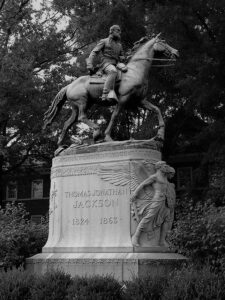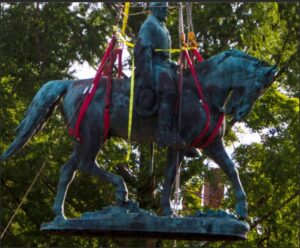
Charlottesville’s monument to Stonewall Jackson (1921) was removed from a park next to the Albemarle County Courthouse in July 2021. It was subsequently sold to a Los Angeles “visual art space” and is in danger of destruction. (Nickmorgan2, Wikimedia Commons, rendered in grayscale)
In Charlottesville and Richmond, the fate of historical statuary hangs in the balance.
by Catesby Leigh
Charlottesville’s public spaces suffered major degradation after George Floyd’s killing, thanks to the removal of five noteworthy statuary works erected between 1909 and 1924: a Confederate sentinel known as Johnny Reb perched on an elaborate pedestal flanked by two cannons in front of the Albemarle County Courthouse; equestrian statues of Robert E. Lee and Stonewall Jackson; a Lewis and Clark monument that included the crouching figure of their Shoshone interpreter Sacagawea; and a monument to Revolutionary War hero George Rogers Clark, famous for his exploits in what became the Northwest Territory. This tribute to the “Conqueror of the Northwest” included seven figures in a scenographic tableau, with Clark alone on horseback as his party encountered a group of Indians.
Except for the Johnny Reb, these monuments were the work of noted artists and individually designated on the National Register of Historic Places as well as the Virginia Landmarks Register. All, again excepting the Johnny Reb, were donated by an exceptionally generous philanthropist, investment banker Paul Goodloe McIntire (1860–1952).
And all ran afoul of racial-grievance activists, whether black or Native American, and their indispensable coterie of woke white allies convinced that the monuments’ removal will somehow improve the lives of historically marginalized minorities. It won’t, and the grievance community will just move on to the next hot-button issue. Only the handsomely decorated pink-granite pedestal of the Lewis and Clark, rising from a lushly planted traffic island, remains. Evidently the pedestal is considered politically acceptable in the statuary’s absence, especially that of the unacceptably subordinate figure of Sacagawea. Continue reading



